Introduction
- Books Name
- CBSE Class 6 Science Book
- Publication
- Param Publication
- Course
- CBSE Class 6
- Subject
- Science
Importance of Measurement
Measurement is an integral part of modern science as well as of engineering, commerce, and daily life.
In daily life, the importance of measurement is well known. When we have to bring fruits, vegetables etc. from the market then the seller measures their quantity using beam balance and we have to pay him accordingly. The tailor needs exact measurement of our body to stitch our dresses. Thus we can conclude that measurement is an essential part of everyday life.
* Measurement : It is the determination of the dimensions, quantity or capacity of an item.
Or comparing an unknown quantity with some known quantity is called measurement.
* Physical quantity : Any quantity that we study in physics ( e.g. length, mass and time) is called physical quantity. A physical quantity is a property of an object that can be measured with a measuring instrument.
To measure physical quantities such as mass, time and length, we use units such as kilogram, second, and metre.
* Unit : A physical quantity (Such as length) has to be measured with respect to some known quantity. This known quantity is called a unit.
Representation of Measurement:
The result of measurement has two parts; one part is the number and another part is the unit. The known quantity which is used in measurement is called a unit.
Example; when you say that your height is 150 cm then the measurement of your height is being expressed in a number, i.e. 150 and a unit, i.e. centimeter.
Story of transport
- Books Name
- CBSE Class 6 Science Book
- Publication
- Param Publication
- Course
- CBSE Class 6
- Subject
- Science
History of length measurement
Arbitrary Units of Measurement: Before the development of standard units of measurement, people used arbitrary units of measurement. Some of them are still in use at some places. Handspan,
finger-length, cubit (length between the elbow and finger tips), foot-length and arms-length are some examples of arbitrary units of measurement.
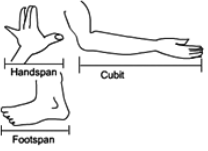
Disadvantages of Arbitrary Units of Measurement: You have seen that arbitrary units are made up of lengths of different body parts. These lengths can vary from one person to another. This can create lot of confusion as there would be no uniformity in measurement. We need standard units of length and other physical quantities to obtain the same value for a measurement.
How wide is this desk?
- Books Name
- CBSE Class 6 Science Book
- Publication
- Param Publication
- Course
- CBSE Class 6
- Subject
- Science
Standard Unit of Measurement
To maintain uniformity in measurement, standard units of measurement were introduced in different parts of the world at different places. It have a fixed quantity and, therefore, do not vary from person to person and place to place. For example, the metric system, created by the French in 1790, is a standard set of units. Adopting standard units of measurement solves only half the problem. People in different countries may be using different sets of standard units for measurement. For example, gram and pound set of units. The adoption of SI units has made it easier for scientists of different countries to communicate their results to one another.
SI Unit (International System of Units): The SI system of units was adopted in 1960 by the General Conference of Weights and Measures. SI is the short form of system of International Units (in French).
It is the most widely used system of measurement in the world. It is based on MKS (Meter-Kilogram-Second) System. Length, weight and time are considered as basic quantities for measurement and other quantities are derived from them. As per SI system; the unit of length is meter, unit of weight is kilogram and the unit of time is second.
Depending on the size of the object we wish to measure, we have to choose an appropriate unit. For example, we use metres to measure the length of a piece of cloth, kilometres to measure the distance from one place to another, millimetres to measure the thickness of the hair, and so on. Units of length can be interconverted by multiplying or dividing their values by 10, 100, 1000, and so on.
A commonly used unit for measuring large distances is the kilometre (represented as km). Commonly used units for measuring small distances are the centimetre (cm) and millimetre (mm).
1000 m = 1 km
100 cm = 1m
1000 mm = 1 m
For measuring lengths smaller than the metre, its sub-multiples are used. For lengths greater than the metre, its multiples are used , Those are given in following table:-
Relation between some units :
10 mm =1 cm, 10 cm = 1 dm, 10 dm = 1 m;
10m = 1 dam, 10 dam = 1 hm, 10 hm = 1 km
Some measurements
- Books Name
- CBSE Class 6 Science Book
- Publication
- Param Publication
- Course
- CBSE Class 6
- Subject
- Science
MEASUREMENT OF LENGTH
The length of an object is the distance between its ends. It can be measured using a ruler, a measuring tape, a metre rod , and so on whichever is convenient for the required purpose.
![]()
A ruler
While measuring length using a ruler, we have to take the following precautions :
(i) Care should be taken to keep the ruler along the length of the object.

The ruler should be kept along the length of the object.
(ii) If the edge of the ruler is worn out or broken, the measurement should be stared from any other mark that is fully clear.
 Measurement should only be started from a mark that is fully clear.
Measurement should only be started from a mark that is fully clear.
(iii) Eyes should be exactly above of the point where the measurement is to be taken.
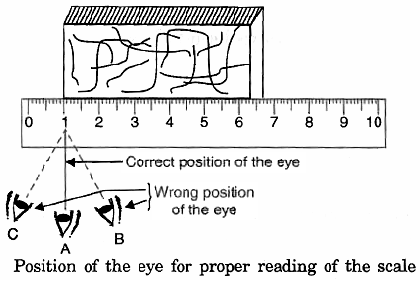
Standard Units of Measurements
- Books Name
- CBSE Class 6 Science Book
- Publication
- Param Publication
- Course
- CBSE Class 6
- Subject
- Science
Using a Divider to Measure Length
A divider is used to measure the distance between two points. The correct use of a divider can give a fairly accurate measurement. The divider is placed such that its two points are at the two ends of the length to be measured. Then, without disturbing the divider, the distance between the two points is measured with a ruler .

Measuring the Length of a curved Line
We can measure the length of a curved line by using a string. The string is placed along the curved line and its ends are marked on the string The length of the string between the marked points is measured with a ruler .
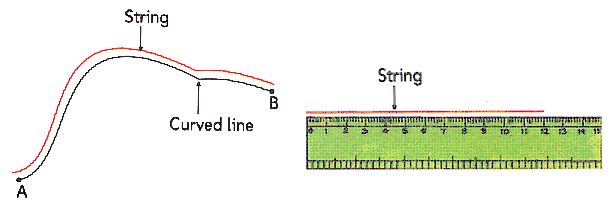
Correct Measurement of Length
- Books Name
- CBSE Class 6 Science Book
- Publication
- Param Publication
- Course
- CBSE Class 6
- Subject
- Science
Measurement of Area
The amount of surface covered by the object is called its area. The measurement of area counts two dimensions. The SI unit of area is square metre, represented as m2. This is the area covered by a square whose length and breadth are 1 m each.
The area of regular surfaces (squares, rectangles etc.) can be measured by using the following formula:
area of a square = length × length
area of a rectangle = length × breadth
Ex.1 How many m2 are equal to 1 cm2 area?
Sol. 1 m2 = 1 m × 1 m
= (100) cm × (100) cm
= (10000) cm2 = 104 cm2
Measurement of volume
The amount of space occupied by an object is its volume. The SI unit of volume is the cubic metre represented as m3 .
The litre (represented as l) is an important unit of volume used in the everyday life.
1 litre = 1000 ml
1 m3 = 1000 litres
The litre is also known as 1000 cm3.
Since 1 litre = (1/1000) m3.

The volume of a liquid is more often expressed in millilitres.
The volume of a solid that has a regular shape can be calculated using a mathematical formula. The formula for determining the volumes of some regular solids are:
Volume of a cube = l3
where l is the length of the side of the cube.
Volume of a cuboid = l × b × h
where l is the length, b is the breadth, and h is the height of the cuboid.
e.g. Volume of a cube of side 1 m
= 1m × 1m × 1m
= 1 × 1 × 1 m3
= 1 m3
Volume of a cube of side 1 cm
= 1 cm × 1 cm × 1 cm
= 1 × 1 × 1 cm3
= 1 cm3
Volume of a cube with sides 10 cm
= 10 × 10 × 10 cm3 = 1000 cm3
Volume of a cube with sides 1 dm
= 1 × 1 × 1 dm3 = 1 dm3
1000 cm3 = 1 dm3
1 litre = 1000 ml
= 1000 ml
or 1 cm3 = 1 ml
Ex.2 Convert :
(i) 54 km/hr = ? m/s (ii) 15 m/s = ? km/hr
(iii) 30 km/cm = ? m/mm (iv) 12 m/km = ? mm/cm

Measuring the length of a curved line
- Books Name
- CBSE Class 6 Science Book
- Publication
- Param Publication
- Course
- CBSE Class 6
- Subject
- Science
Concept of rest and motion
(a) Rest :
An object is said to be at rest if it does not change its position with respect to its surroundings with the passage of time.
(b) Motion :
A body is said to be in motion if its position changes continuously with respect to the surroundings (or with respect to an observer) with the passage of time.
Note : Rest and motion are interrelated to each other. An object at rest with respect to one observer may not be at rest with respect to another observer. The same can be said about motion. For a person inside a bus, the fellow passengers are at rest but the same passengers are in motion with respect to a person standing on the ground.
Moving things around us
- Books Name
- CBSE Class 6 Science Book
- Publication
- Param Publication
- Course
- CBSE Class 6
- Subject
- Science
Types of Motion
(i) Random Motion : Motion having no specific path
Example : Motion of butterfly, Motion of kite.
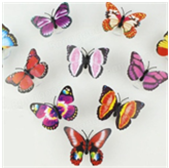
(ii) Translational Motion : Motion in which all particles of a moving body describes identical trajectory.
(a) Rectilinear Motion : When a body moves in straight line, it is known as rectilinear motion. It is also called linear motion.
Example : The motion of a moving car, a person running, a stone being dropped, motion of a train on a straight track

(b) Curvilinear Motion : When a body moves in a curve path, it is known as curvilinear motion.
Example : Car moving on a curved road.

(c) Circular Motion : When a body moves in a circular path, its motion is known as circular motion. In circular motion, the object remains at the same distance from a fixed point.
Example : Motion of the tip of the clock’s arm, motion of the earth around the sun, motion of blades of fan.
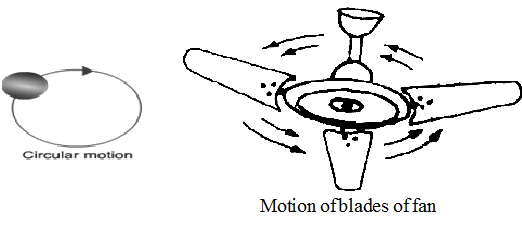
(iii) Rotational Motion : Motion in which a whole body move about an axis is called a rotational motion.
Example : Motion of top, Rotation of earth
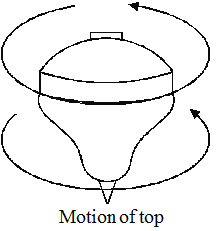
(iv) Periodic Motion : Motion in which an object repeats its motion after a fixed interval of time is called periodic motion.
Examples :
(ii) Motion of a swing.
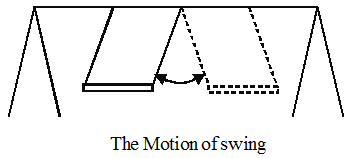
(a) Oscillatory Motion : The to and fro periodic motion of a body about a fixed point is called oscillatory motion.
Example : The motion of a simple pendulum, a body suspended from a spring (also called to and fro motion).

Types of motion
- Books Name
- CBSE Class 6 Science Book
- Publication
- Param Publication
- Course
- CBSE Class 6
- Subject
- Science
Distance
Distance is the actual path travelled by a body in a given time. Consider a body travelling from A to B along any path between A and B. The actual length of the path that a body travels between A and B is known as the distance. Here if the body goes from A to B via C, the distance travel will be ACB. The distance travelled will be different for different paths between A and B.

Speed
The distance travelled by a body in unit time is called its speed.
Therefore, speed = Distance/Time

(a) Uniform Motion : A body has a uniform motion if it travels equal distances in equal intervals of time, no matter how small these time intervals may be. For example, a truck running at a constant speed of say, 20 m/s, will cover equal distances of 20 metre, in every second, so its motion will be uniform.
Or
If it moves along a straigth line with a constant speed it is said to be in uniform motion.
(b) Non-Uniform Motion : A body has a non-uniform motion if it travels unequal distances in equal intervals of time. For example, If a car moving on a highway , we will find that it covers unequal distances in equal intervals of time. It covers :
5.9 metre in the 1st second,
15.7 metre in the 2nd second,
30 metre in the 3rd second, and so on.
Or
If the speed of an object is not moving along a straigth line keeps changing, its motion is said to be non-uniform.
Uniform and Non-uniform motion can be shown graphically also
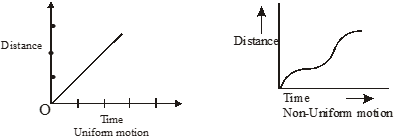
Ex. 3 A body satrts from A and moves according to given figure. Time for each interval is :
tAB = 2s, tBC= 3s, tCB=2s, tBA = 3s, tAD= 4s

The distance, speed are as follows for different path.
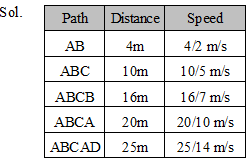
Ex.4 A car travels a distance of 100 Km in 25 minutes to reach a place then calculate the speed of the car :
(A) 4 km/min (B) 4 m/min (C) 400 m/min (D) None of these

Ex.5 If an object travels with the speed 18 km/hr for 20 minute find the distance covered by the object.
Sol. Speed = 18 km/hr, time = 20 min
Distance = speed × time
![]()
Extended Learning – Activities and Projects (Part -1)
- Books Name
- CBSE Class 6 Science Book
- Publication
- Param Publication
- Course
- CBSE Class 6
- Subject
- Science
Extended Learning – Activities and Projects
1. To measure the height of a person.
Materials required : Measuring tape, a thick book, and a pencil.
Procedure : To measure the height of your friend, make him / her stand absolutely straight with his/her back against a wall. Place a thick rigid book on his/her head and make a mark on the wall where the underside of the book touches the wall. Measure the length from this mark to the floor with the help of the measuring tape. This gives the height of your friend make sure he/she is not wearing shoes to gain some extra inches.
2. To measure the thickness of a sheet of paper of your science book.
It is not easy to measure the thickness of a single sheet of paper by using metre scale. The method used to find the thickness of a single sheet is as follows :
Take 100 sheets of paper together. Find their combined thickness by using a centimetre scale. Divide the total thickness by the number of sheets. It is the thickness of a single sheet. For example: If the thickness of 100 sheets = 1.5 cm.
![]()
3. To measure the diameter of a ball with the help of metre scale.
The diameter of a ball can be measured correctly with the help of metre scale. It is one of the ways in which diameters of spherical surface can be measured easily. In this method, the two wooden blocks A and B must be exactly parallel to each other
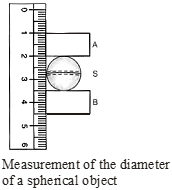
4 To measure the thickness of a thin wire.
Take a round pencil and wrap the given wire round the pencil making 25 turns forming a coil. Measure the length of the so formed coil. Divide the total length of the coil by number of turns. This is the thickness of the wire.
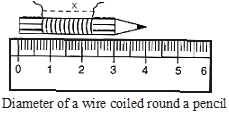
Extended Learning – Activities and Projects (Part -2)
- Books Name
- CBSE Class 6 Science Book
- Publication
- Param Publication
- Course
- CBSE Class 6
- Subject
- Science
5. To measure the thickness of a coin.
Take ten coins and put them one over another. Find the total thickness of ten coins with the help of a scale. Divide the total thickness by the number of coins.

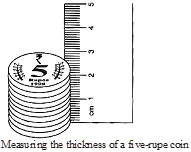
6. To measure the length of any curved line using divider
To measure the length of curved lines we have to use divider. Let there be a curved line AB. Open the legs ofthe divider to cover some convenient distance, say 5 mm. Place one leg of the divider at one. End of the curved line. Put the other leg on the line. Now count the number of times the divider has to be taken along the line to cover the entire length of line AB. At the end, some portion of line may be left out, being less than the distance between the two legs. Measure it separately by adjusting the divider. Multiply the number of complete steps by the distance between the two legs. Add the length of the remaining distance to this length. You will get the total length of curved line.
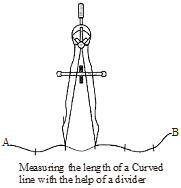
7. Write name of the objects which are in rest and motion.
A school bag, a mosquito, a table, people sitting on desks, people moving around? May be a butterfly, dog, cow, your hand, a small baby, a fish in water, a house, a factory, a stone, a horse, a ball, a bat, a moving train, a sewing machine, a wall clock, hands of a clock? Make your list as large as you can. Which of these are moving? Which are at rest?
Objects at rest Objects in motion
House A flying bird
Table Second's hand of the clock
Clock
Let Us Recapitulate
- Books Name
- CBSE Class 6 Science Book
- Publication
- Param Publication
- Course
- CBSE Class 6
- Subject
- Science
1. In ancient time man used to move only on foot and carry goods either on his back or on the back of some animals.
2. A great change in the modes of transport was made:
(i) by the invention of wheel. (ii) by the invention of steam engine.
3. Non-standard measures: The lengths of steps, arms, hands, or fingers of different people are different, therefore the distance measured with their help is not always reliable. These methods are, therefore, called non-standard measures.
4. Standard measures: Measures that are the same allover the world are known as standard measures.
5. In October 1960, the 12th general conference on weight and measures adopted the International system of units. "The System International Units" is the set of units to maintain uniformity all over the world.
6. Metre: It is the standard unit of length. The symbol of metre is m.

Each metre (m) is divided into 100 equal divisions, called centimetre (cm). Each centimetre has ten equal divisions, called millimetre (mm). Thus
1 m = 100 cm
1 cm = 10 mm
For measuring large distances, metre is not a convenient unit. We define a larger unit of length. It is called kilometre (km).
1 km = 1000 m.
7. Simple multiples of units: Units that are used for the measurement of larger distances are the multiples of SI unit. For example: deca, hecto, kilo.
1 decametre = 10 m
1 hectometre = 100 m
1 kilometre = 1000 m
8. Sub-multiples of units: Units used for measuring smaller distances are the submultiples of SI units. For example, milli, centi, deci.
1 m = 10 decimetre
1 m = 100 centimetre
1 m = 1000 millimetre.
9. Making measurement of a length: In making measurement of length of an object, we should follow the following procedure:
(a) Place the scale in contact with the object along its length as shown in Fig.
(b) Measurement with a scale with broken ends
(i) Avoid taking measurements from zero mark.
(ii) Use any other full mark of the scale, say 1.0 cm. [Fig. (a)]
(iii) Subtract the reading of this mark from the reading at the other end. For example, in Fig. (b), the reading at starting mark 1.0 cm and at the other end it is 6.5 cm. Therefore, the length of the object (6.5 – 1.0) cm = 5.5 cm.
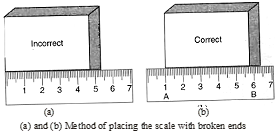
(c) Correct position of the eye is also important for making measurement. Your eye must be exactly above the point where the measurement is to be taken.
10. Least count: A scale is marked in centimetres and millimetres. With the scales of this kind we can measure correctly up to one millimetre, that is one-tenth of a centimetre. This is called the least count of a (15 cm) scale.
11. Measuring the length of a curved line: We cannot measure the length of a curved line directly by using a metre scale. We can use a thread or divider to measure the length of a curved line.
12. Motion: It is a state of objects in which they are moving, that is, they are changing their place with the changing time.
13. Rest: All the stationary objects which are not in motion, that is, do not change their place with time are said to be at rest.
14. Rectilinear motion: When the objects change their position with time along a straight line, this type of motion is called rectilinear motion.
15. Circular motion
(i) When a body moves in a circular path, its motion is known as circular motion.
Examples: (a) motion of stone tied in a thread and whirled.
(b) motion of a blade of an electric fan.
(c) motion of second's hand in a clock.
(ii) In circular motion, the object remains at the same distance from a fixed point.
16. Rotational motion: Motion in which a whole body moves about an axis is called a rotational motion. Example: motion of a top.
17. Periodic motion: Motion in which an object repeats its motion after a fixed interval of time is called periodic motion.
Examples:
(i) Oscillations of a pendulum
(ii) Motion of a swing.
18. Combination of two or more types of motions: In some situations, the motion of an object may be a combination of two or more of the blow mentioned types of motion.
Examples:
(i) Motion of a ball on the ground. Here, the ball is rotating about an axis but the axis itself is moving along a straight line. Thus, the ball executes a rectilinear motion as well as rotational motion.
(ii) Motion of earth-earth executes rotations on its axis and also revolves around the sun.
19. Unit of measurements
(i) It involves the comparison of an unknown quantity with some known quantity of the same kind.
(ii) This known fixed quantity is called unit.
(iii) The result of measurement is expressed in two parts. One part is a number the other part is the unit of measurement.
KEY WORDS
1. Circular motion: When a body moves in a circular path, its motion is known as circular motion.
2. Distance: Measurement of gap between two points in certain units is called distance.
3. Measurement: Measurement means the comparison of an unknown quantity with some known quantity.
4. Motion : It is .a state of objects in which they are moving that is, they are changing their place with time.
5. Periodic motion: Motion in which an object repeats its motion after a fixed interval of time is called periodic motion.
6. Rectilinear motion: When the objects change their position with time along a straight line, this type of motion is called rectilinear motion.
7. SI units: In October, 1960 the 12th general conference on weight and measures adopted in International system of units to maintain uniformly all over the world. This system of units is called SI units.
8. Units of measurement: Measurement means the comparison of an unknown quantity with some known quantity. This known fixed quantity is called a unit of measurement.

 Param Publication
Param Publication
 PathSet Publications
PathSet Publications
